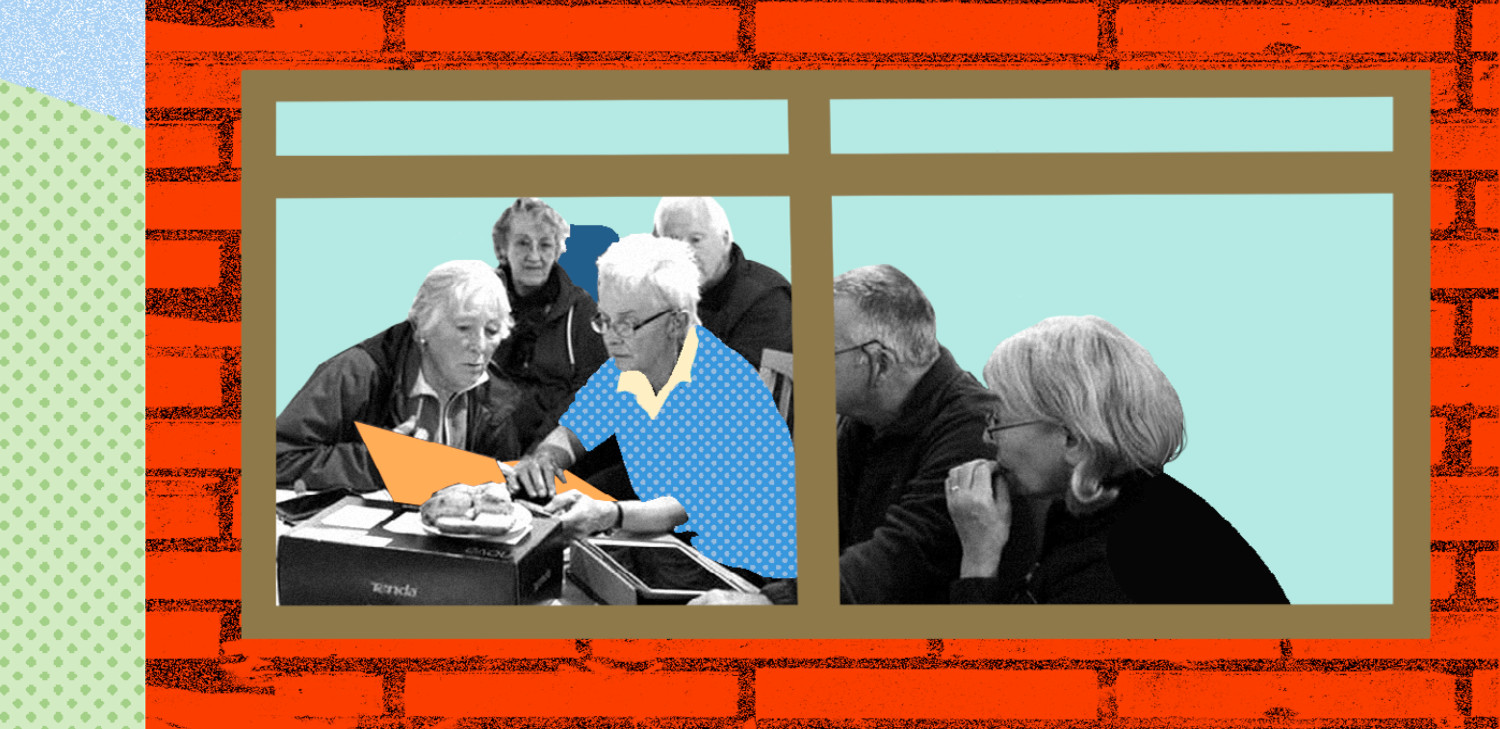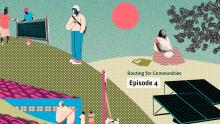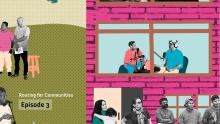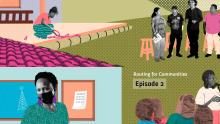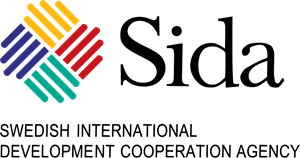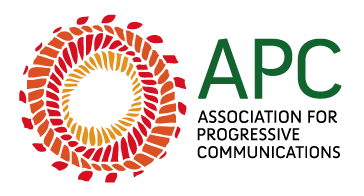#9 The story of B4RN and the power of joint action
In our ninth episode, you’ll get to know an initiative that has already connected over 7,000 homes in England’s northwestern rural areas to the internet: the Broadband for the Rural North project, more commonly known as B4RN. To tell us this story, we interviewed Chris Conder, one of B4RN’s founders who was once recognised by Queen Elizabeth II for her work in taking internet connection to rural communities.
You will also get to know Steve Song, an expert in the realm of community networks. He is a researcher and consultant on technologies that enable wider access to the internet, especially in African countries and other emerging regions. We talked to him about the challenges faced by community networks in terms of sustainability.
“Routing for Communities” is a 12-episode podcast. Here you will listen to the life stories of people who have come up with alternatives to overcome the challenges of digital inclusion in remote, rural and urban areas across the globe.
Stories and voices that are intertwined, connected by one thread: building internet and communication community networks.
Hello! I am Renata Porto. I am from São Paulo, Brazil. I´m here to take you on a journey around the world. We are going to get to know experiences of internet and communications community-led networks throughout this 12-episode season.
In the ninth episode of this series, we’ll get to know a little bit about B4RN, Broadband for the Rural North. This is a Community Benefit Society in England, which means that the organisation must serve the broader interests of the community and that any surpluses has to go right back into the community. The members of the community themselves own the initiative that takes internet connection to the inhabitants of many villages in the region.
“We've done it and we've done it really, really well. And it works and it's viable and it's economical and it's owned by the people. It's looked after by the people.”
This is Chris Conder, one of B4RN’s founders who was recognized from Queen Elizabeth II for her work in taking internet connection to rural communities.
In this episode, you will also get to know Steve Song, an expert in the realm of community networks. He is a researcher and consultant on technologies that enable wider access to the internet, especially in African countries and other emerging regions.
“We actually need a multiplicity of business models and technologies to provide access to… affordable access to all.”
Are you ready? So, let’s go on this trip!
Routing for communities: An audio journey tracing community connectivity around the world.
At first we had a bit of technical issues regarding the sound in our videocall with Chris Conder, but she quickly put on her earphones with a mic and the problem was solved. Then, our team started the conversation with her.
“And how are you? How's it been [with] your week?
"It's fine. Yes, we're busy digging an area out on the farm. So, I'm moving trees at the moment. So I thought: ‘Well, I'll come in for a brew and see what happens with this call and then that gives me a bit of a rest and then I'll go back to move in trees.’ They're digging them out. I'm planting them."
As you may have already noticed, Chris lives on a farm. It is located in Northern England, in a small village called Wray. It is part of the civil parish of Wray-with-Botton, in the City of Lancaster District, in Lâncashire County.
Wray’s local population does not reach even 500, half of them are over 50, and almost everyone is white. Wikipedia has this to say about Wray: “The village has a general store with a post office. The village also has a pub, The George and Dragon; a tearoom, Bridge House Farm Tearooms; and the Bridge House Bistro.” The Wikipedia entry also contains the following sentence: “Wray has a wireless broadband network.”
Now let’s get back to Chris and B4RN to get to know a little bit about this initiative that has already connected over 7 thousand homes in England’s Northwestern rural areas. The initiative, besides counting on the work of volunteers who contribute with local infrastructure, employs some 80 people in the region to run the network on a daily basis.
"Hi, my name's Chris Conder. I'm 69 years old at the moment. I've been involved with trying to get internet connectivity to my communities since I was 40, so I've been doing this for 29 years. And we got more active in the year 2000 because so many other people and villages were getting broadband and our dialogue was awful, and it's a very long story, but we started in about 2000 getting serious. In 2003, we got involved with a local university, Lancaster University. With this network research special projects unit, and we sort of started until they eventually helped us build a research project in our village. I lived on a farm, I'm a farmer's wife, I was still active on the farm. I had three children and I was a mobile hairdresser. As a hairdresser, I went around all the community, from nursing homes to people's houses, people with children, older people and I talked about the internet and getting the internet to our families and businesses and asked their opinion of it. So over quite a big area that I worked, I listened to what people wanted and it was exactly what I wanted and so we formed a group and, like I said, we nagged the university to help us."
The partnership with the university developed only gradually. At first, the university’s broadband connectivity signal did not reach small villages, so more studies were needed, working with the members of the community. But there wasn’t enough funding then, nor was there government support for such development.
Chis reported that, even without broadband access in the village, there was a computer club. There, people, mostly older citizens, started to learn to use spreadsheets and other apps, how to use search engines and shop online, as well as how to burn their favourite songs on CDs. These were ways of raising interest and motivating people to use digital technologies.
In the early 2000s, Chris and the others organised themselves to seek solutions to the internet access gap they experienced. In order to overcome financing issues, they raised money amongst the inhabitants. Some initial steps were also made possible with government funds.
Chris tells us they submitted a proposal for the “Project Access” open call, which was a 20-million pounds pot of money from the Northwest Development Agency to take up innovative projects to bring digital connectivity to rural areas.
However, they did not get enough money to implement all that they needed. So, Chris and another community member, Debbie, carried out the research themselves, allowing the funds received from the agency to be invested in the infrastructure costs for a shared wireless network which were basically six mesh Wifi boxes and antenna. That's how they built “a network that works” with their own hands.
With a wireless connection to the university, they were able to reach a little over 20 clients. But as soon as YouTube and IPlayer – a streaming service linked to BBC – began to grow in popularity in the community, the network was no longer able to cope with demand. If someone decided to download something, they overloaded the network, which left the others unable to connect. That happened around 2005.
A few years later, the seeds of a new initiative were planted. People from eight villages in the region gathered around a funding management committee.
"Each of those people brought different skills to the pot. So one was an accountant, one was an engineer, one was a doctor. There were all different mindsets of people on the management committee. And Barry drew up a business plan which we kept inspecting and looking at and adding things to, but it was Barry's genius plan. And we went to the city council, who were going to be our sponsors, because we weren't anybody, we were just a management team of community cases. So the project will be fronted by the city council, who were fully supportive of getting the internet to eight of their parishes. No cost to themselves, because this was the grant. And so, three quarters of a million pounds according to our plans would have built a backbone. So, from a breakout point of dark fibre, we could then feed our own fibre to our eight communities."
Barry, mentioned by Chris, is Barry Forde, a retired professor from Lancaster University, who was an essential element of the project. He, Chris and other founding members turned B4RN into reality. The organisation was established in 2011, after long discussions and conversations in the community. It was a collective cooperation.
In the beginning, the plan was to take fibre to what they used to call "digital parish pumps", so that each community could use the structure however they saw fit, be it with landlines, Wi-Fi hotspots, or even fibre for people’s houses.
But the plan grew and, ultimately, the idea was to take fibre to everybody’s homes, which would significantly increase the project’s costs. Subscribers’ payments would no longer be enough. So, talking to the local postman, Chris came up with an idea.
"The village postman was having his haircut with the village hairdresser, and the village hairdresser was droning on like she did; instead of about holidays, which most of the hairdressers drone on about, she was droning on about broadband and how this, the original plan, was to go through the roads and pavements. And this postman who drove all over those eight parishes, just like the hairdresser, said: “Well, if you go in from Quernmore to Wray, for example, which was my village, Quernmore was the breakout point, and you're thinking of going through Lancaster and through Caitan and through all the roads which will take forever. Why don't you just go over the farms and you just skip over the fells through the easy peat, dig through that and you're in in a jiffy and it's not going to cost you very much, because the farmers will dig it for you, because the farmers on the fell are desperate for a good connection. And do it that way.” So that was the actual seed that started the theory that yes, we can do it ourselves."
Thus, many volunteers were recruited amongst the neighbours, which not only lowered their costs but involved the community even more, they negotiated licences for free access through their lands and shared resources such as shovels, excavators, drills and other equipments. The first village to be connected was Quernmore, in 2012. And in Conder’s village, Wray, almost 20 km away, broadband became a reality in 2014.
A few hours after our videocall, Chris sent us a three-minute video produced by herself in order to tell the story of the excavation process to install fibre in her land.
"Nine o'clock in the morning, I decided I was going to lay some fibre, so I got on the phone, I got hold of the fibre team, who brought the fibre in the car. They had to cut the side off to get it in 12-core, single-mode fibre around Lucid, who are the lighting team around the digger-men. By three o'clock, the team was complete and we set off on our fibre dig. This is the action as you can see is the biggest mess…"
Another interesting element worth mentioning about B4RN’s long history is their relationship with government and public policies. Chris is very critical of the support provided by the United Kingdom’s government and administration to local communities. In B4RN’s case, for instance, it took many years until initiatives and resources finally arrived. The system that has worked is that of vouchers.
B4RN is registered as a service provider with the UK Gigabit Voucher scheme, for which funding is provided by the Department for Science, Innovation, and Technology.
Through this scheme, funding reaches the communities in the form of vouchers where, if you connect a house in a rural area, you get 1500 pounds as benefit from the government, without any cost.
It works like this: in areas lacking connectivity infrastructure and where a licence to operate is granted, when people start using the service in a residence or company, the government sends an email to the client seeking their feedback. If the client is satisfied with the service, the government sends the voucher to the provider.
The system provides a guaranteed source of funding, without the need to raise money in the parishes.
According to the website Cable.co.uk, the average cost for broadband in the United Kingdom is around 0.86 pound per megabit per month (almost 1 dóllar) . B4RN’s official price is closer to 0.03 pound per megabit. In other words, the network built by the community offers high-quality connection at significantly lower costs for the users.
"We've done it and we've done it really, really, well, and it works and it's viable and it's economical and it's owned by the people; it's looked after by the people. It's built so much community cohesion. It is unbelievable how everybody in the community has got to know everybody else and gone on to help the next community and the next parish and got to know them. And they are still supportive now."
Now, we’re crossing the ocean from England to Canada, to talk to Steve Song. He is a researcher and consultant on digital technologies and an expert when it comes to debates on community-led networks.
"My name is Steve Song, I'm a policy advisor with the APC LocNet project, providing support on policy and regulatory issues for the project. I do that half [the] time; the other half of my time I spend as a policy advisor to the Mozilla Corporation, who make the Firefox browser. I'm a Canadian-South African. And I first, I think, became interested in the transformative potential of access to the internet, when I started working with APC in the early 1990s, in South Africa, to facilitate access to email for those working within the mass democratic movement in South Africa."
We kept on going with Steve by asking him what would be some of the challenges in terms of sustainability for community networks. He tells us that, on the one hand, there is a regulatory environment which allows (or not) that they prosper.
There are cases such as the United Kingdom, North America, or even some European countries where one does not need a licence to establish a community-led network. All it takes is an antenna in your house and you can start providing the service. If you charge for the service, then you’ll need to be registered as a company, but aside from that, there is no other immediate requirement.
But in most countries worldwide, this is not the reality. In fact, in almost all the countries you need a licence to offer any type of internet service. This comes with implications, such as understanding the sometimes complex administrative processes involved in applying for a licence. Communities can face a variety of other challenges. For example, some countries have duties and taxes on the import of equipment, which can be an obstacle for rural and or low-income communities.
There’s also the more general difficulty of accessing funds and financing. Typically, community-led networks get started with grants from civil society organisations, among other articulations, seeking resources to acquire equipment. But that doesn’t guarantee long-term sustainability.
"I kind of remember the belief that it's always good to start out as you mean to continue as an organisation. If your intent is to recover costs from the community, that's not something you spring on them later, right? That's not something that is easy to introduce later. When people are used to having a service for free, and [it’s] something that really needs to be baked into the planning from the very beginning. And this is complicated by the fact that in some areas, there is never really going to be a full business case for community networks, right? In some of the most remote, in some of the poorest areas, the ability to pay is so low that it's never just going to be a simple business that there is always going to be a need for some kind of subsidy and some kind of support to enable access in these regions where providing access is the most challenging and where the ability to pay is at its lowest."
"We talk about them as a range of solutions to access challenges, and this is a kind of shift that is being made globally to recognise that, well, the biggest operators are not going to connect everyone because their business models simply don't extend into rural areas. And that we actually need a multiplicity of business models and technologies to provide access to affordable access to all."
Among the various works, texts, consultancies and lectures Steve has delivered throughout his career, he has become well known for that metaphor about filling a glass jar with stone.
It basically works like this: if you try to fill a jar with large stones, there will be a lot of uncovered gaps. So, aside from big stones, other smaller ones, and of different sizes, are needed so that the jar can be completely filled.
Filling the jar is the same as fulfilling the needs of affordable access to communication for all. Small operators, both for-profit and not-for-profit, are needed to fill the connectivity gaps left by large operators. Policymakers and regulators need to recognise the role that community-owned infrastructure can play by providing enabling regulation and financial incentives to nurture their development.
And we have reached the end of this episode. As always, I hope the stories that were told by voices from different parts of the world were a source of learning and hope, while at the same time leading us to act, together and collectively.
If you’d like to know more about B4RN and its work in Northern England, as well as research and other discussions by Steve Song, look up the websites we have left in this episode’s description.
If you’ve liked this podcast, please help us to share these voices. recommend this podcast to those you know will appreciate it as well.
You can follow the season on the main podcast platforms or on APC’s website: routingforcommunities.apc.org.
We’ll meet again soon, with new experiences and stories from community-led networks that are also connected to our lives.
For the 10th episode, we will get to know the Jxa'h Wejxia Casil community, in Colombia, via Edinson Camayo, Indigenous leader of the Nasa Nation and the project’s coordinator.
You’ve listened to the ninth episode of “Routing for communities: An audio journey tracing community connectivity around the world”. This is the podcast of the Local Networks initiative, a collective effort led by APC and Rhizomatica. Production: Rádio Tertúlia.
Thanks, and see you next time!
Credits
This podcast is an initiative from the Association for Progressive Communications (APC) and Rhizomatica, produced by Rádio Tertúlia.
Script and production: Vivian Fernandes
Script translation: Thiago Moyano
Presentation: Renata Porto
Editing and sound: Beatriz Pasqualino
Coordination: Beatriz Pasqualino and Débora Prado
Consulting Board: Flavia Fascendini, Kathleen Diga, Cynthia El Khoury, Bruna Zanolli, Nils Brock, Adrián López, Steve Song and Daniela Bello
Illustrations: Gustavo Nascimento
Web design: Cathy Chen and Avi Nash
